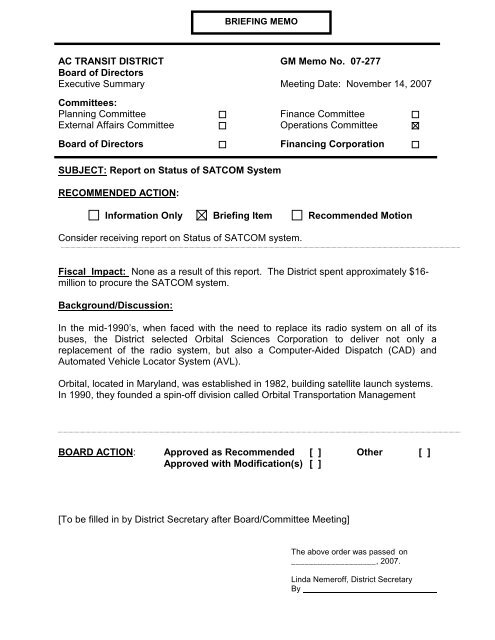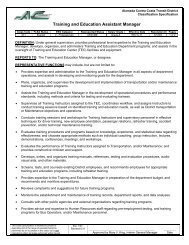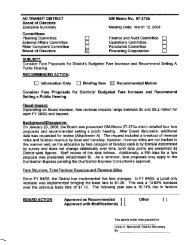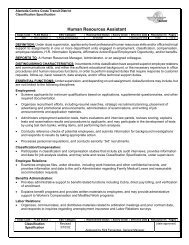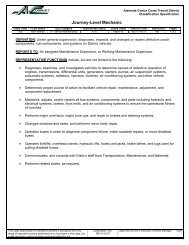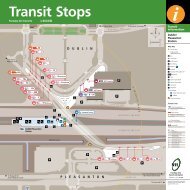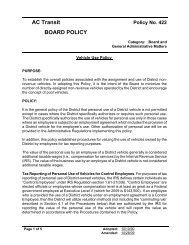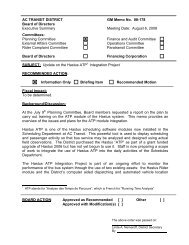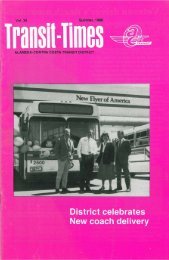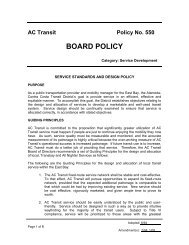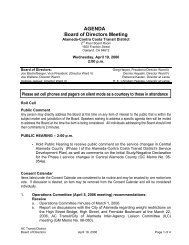GM Memo No. 07-277 - AC Transit
GM Memo No. 07-277 - AC Transit
GM Memo No. 07-277 - AC Transit
Create successful ePaper yourself
Turn your PDF publications into a flip-book with our unique Google optimized e-Paper software.
BRIEFING MEMO<br />
<strong>AC</strong> TRANSIT DISTRICT <strong>GM</strong> <strong>Memo</strong> <strong>No</strong>. <strong>07</strong>-<strong>277</strong><br />
Board of Directors<br />
Executive Summary Meeting Date: <strong>No</strong>vember 14, 20<strong>07</strong><br />
Committees:<br />
Planning Committee<br />
External Affairs Committee<br />
Board of Directors<br />
Finance Committee<br />
Operations Committee<br />
Financing Corporation<br />
SUBJECT: Report on Status of SATCOM System<br />
RECOMMENDED <strong>AC</strong>TION:<br />
Information Only Briefing Item Recommended Motion<br />
Consider receiving report on Status of SATCOM system.<br />
Fiscal Impact: <strong>No</strong>ne as a result of this report. The District spent approximately $16-<br />
million to procure the SATCOM system.<br />
Background/Discussion:<br />
In the mid-1990’s, when faced with the need to replace its radio system on all of its<br />
buses, the District selected Orbital Sciences Corporation to deliver not only a<br />
replacement of the radio system, but also a Computer-Aided Dispatch (CAD) and<br />
Automated Vehicle Locator System (AVL).<br />
Orbital, located in Maryland, was established in 1982, building satellite launch systems.<br />
In 1990, they founded a spin-off division called Orbital Transportation Management<br />
BOARD <strong>AC</strong>TION: Approved as Recommended [ ] Other [ ]<br />
Approved with Modification(s) [ ]<br />
[To be filled in by District Secretary after Board/Committee Meeting]<br />
The above order was passed on<br />
___________________, 20<strong>07</strong>.<br />
Linda Nemeroff, District Secretary<br />
By
<strong>GM</strong> <strong>Memo</strong> <strong>No</strong>. <strong>07</strong>-<strong>277</strong><br />
Subject: Report on Status of SATCOM system<br />
Date: <strong>No</strong>vember 14, 20<strong>07</strong><br />
Page 2 of 6<br />
Systems. Using their expertise in Global Positioning Systems (GPS) technology, they<br />
developed tracking systems for public transportation systems. <strong>AC</strong> <strong>Transit</strong> was one of<br />
the early clients for this technology, and called its system SATCOM, short for Satellite<br />
Communications.<br />
The system that the District purchased from Orbital is designed to provide:<br />
<br />
<br />
<br />
<br />
<br />
<br />
<br />
<br />
<br />
a radio system<br />
emergency alarm function, in case of emergencies<br />
real time vehicle location information<br />
two-way messaging<br />
computerized incident reporting forms<br />
vehicle status for route and schedule adherence<br />
historical data<br />
automatic vehicle announcements<br />
automatic passenger counting<br />
Status of Major Features<br />
Radio Functions: The District first began using SATCOM in 2000. The first function<br />
that was used was the radio system, which has three levels of communication with<br />
Central Dispatch (CD) based on the urgency of the call.<br />
For routine business, an operator pushes the “Request to Talk” button, and alerts CD<br />
that he/she wishes to speak to them. For situations involving danger, or the threat of<br />
danger, operators are instructed to push the Priority Request-to-Talk (PRTT) button.<br />
When that button is pressed, CD is alerted that there is something of a serious nature<br />
occurring, and that the operator needs to speak to a dispatcher immediately.<br />
In emergency situations, defined as whenever the operator believes his/her life or the<br />
lives of people on the bus are threatened, operators are trained to activate the<br />
Emergency Alarm (EA) system, one of the most critical functions of the new radio<br />
system. When the system is activated, one-way communication is established so that<br />
CD can monitor the situation on the bus. A GPS system on the bus allows CD staff to<br />
determine the bus location and dispatch appropriate emergency personnel. When the<br />
threat is over, operators are trained to notify CD and advise them of the status of the<br />
situation. The EA feature is used in emergency situations only, and is critical to<br />
improving safety for our operators and customers alike.<br />
Computerized Incident Reporting – The District uses the incident reporting features of<br />
the SATCOM system on a regular basis. At CD, the dispatchers enter information on:
<strong>GM</strong> <strong>Memo</strong> <strong>No</strong>. <strong>07</strong>-<strong>277</strong><br />
Subject: Report on Status of SATCOM system<br />
Date: <strong>No</strong>vember 14, 20<strong>07</strong><br />
Page 3 of 6<br />
<br />
<br />
<br />
<br />
<br />
<br />
incidents and accidents<br />
security-related events<br />
outlates, service cancellations, and delays of service<br />
detours<br />
extra service<br />
roadcalls<br />
This information is used by the relevant District departments to track information they<br />
need. For years, the Maintenance Department relies heavily on the roadcall<br />
information, and uses it to monitor miles between roadcalls at each division and Districtwide,<br />
as well as to monitor trends in the type of roadcalls.<br />
Route and Schedule Adherence Information: The District’s scheduling information from<br />
the HASTUS scheduling system is linked to the SATCOM system to provide information<br />
on route and schedule adherence. In fact, the District and Orbital had a cost-sharing<br />
agreement to procure the HASTUS system, because the previous scheduling system<br />
was not compatible with the Orbital system. The schedule and route adherence<br />
information is used on a real-time basis at Central Dispatch, and historical information<br />
is used to develop more accurate schedules for routes. The District’s consultant, TMD,<br />
used the SATCOM data extensively in developing new schedules for many routes in the<br />
past few years that better matched actual running times. In most cases, this has<br />
resulted in adding time to schedules that consistently ran late. This data has proven to<br />
be an invaluable tool in developing better schedules.<br />
Advanced Functions and Applications to Other Systems: The Orbital system is at the<br />
core of other functions and systems that will further enhance system reliability and<br />
efficiency, as well as customer services. Already, the District has implemented<br />
Automatic Vehicle Announcements (AVA) on the 1, 1R, 72, 72R, and 51 lines. Two<br />
new routes will be added soon: the 57 and 40 lines. After that, the District will continue<br />
rolling out the AVA on the remainder of the trunk routes, followed by the rest of the<br />
lines. These automatic announcements free up the operators from having to orally<br />
announce the stops and are also beneficial to the customers. Additional funding was<br />
budgeted over the next two years to roll out AVA on all of the District’s routes.<br />
The Orbital data is also used currently with the NextBus system to predict bus arrivals.<br />
A detailed report on the status of the NextBus system will be provided to the Operations<br />
Committee next month, as will a report on the potential use of Orbital Automatic<br />
Passenger Counters.<br />
Challenges of the System: Although the District is successfully using the SATCOM<br />
radio function and other high priority functions of the Orbital system, staff realizes that<br />
the District is not using the system to its highest potential. One example of the<br />
challenges that the District faces with the system has to do with operator log-ons. To
<strong>GM</strong> <strong>Memo</strong> <strong>No</strong>. <strong>07</strong>-<strong>277</strong><br />
Subject: Report on Status of SATCOM system<br />
Date: <strong>No</strong>vember 14, 20<strong>07</strong><br />
Page 4 of 6<br />
fully use the system, operators must log-on when they begin to operate the bus. For a<br />
variety of reasons, the District still has not achieved the rate of operator log-ons<br />
necessary to reach the maximum utility of the system.<br />
In March 20<strong>07</strong> a complete system hardware and software refresh was accomplished.<br />
This refresh enabled the CAD/AVL functions to be far more stable along with faster<br />
refresh screens and much better system response times. Besides the performance<br />
enhancements, the refreshed system means that staff can focus on specific efforts to<br />
collect and report on the vast amount of data collected by the system.<br />
One of the biggest challenges also is one of the system’s strengths: the system has<br />
District-wide applications that impact the Maintenance, Planning, Transportation,<br />
Security, Risk, Safety, and Information Systems Departments. As such, it has the<br />
potential to improve functions District-wide, but also requires new ways of doing<br />
business. For nearly two years, District staff from the above departments has been<br />
meeting twice a month to share information and try to solve problems that inhibit the<br />
use of the system to its full potential. Through this effort it has become very clear that<br />
the District needs to devote more resources to making the system work more<br />
effectively. It is equally clear that the District needs to commit staff resources<br />
representing the various departments, each of whom has expertise in their own area<br />
who can work as a team with a larger, system-wide goal in mind.<br />
To that end, effective <strong>No</strong>vember 5, 20<strong>07</strong>, the District has formed an inter-Departmental<br />
Systems Task Force with six team members representing key departments. The team<br />
members were selected because, in addition to being “technical” experts in their area,<br />
they are enthusiastic about taking a fresh approach, and using a team approach to<br />
solve problems and logjams related to Operations Technology. The task force<br />
members include: a Senior Transportation Planner, Transportation Planner/AVA<br />
coordinator, Transportation Planner/NextBus Coordinator, Transportation Supervisor/<br />
Central Dispatcher, Electronic Technician, and IS Project Manager. The group has<br />
begun meeting and drafting long-term and short-term goals.<br />
An Executive Committee composed of the Deputy General Manager, Service<br />
Development, Chief Maintenance Officer, Chief Technology Officer, and Chief<br />
Transportation Officer will meet weekly with the Task Force to set priorities and commit<br />
necessary resources. At this point it is anticipated that the Task Force will remain in<br />
operation for approximately six months, at which time the scope and progress of their<br />
work will be re-evaluated.
<strong>GM</strong> <strong>Memo</strong> <strong>No</strong>. <strong>07</strong>-<strong>277</strong><br />
Subject: Report on Status of SATCOM system<br />
Date: <strong>No</strong>vember 14, 20<strong>07</strong><br />
Page 5 of 6<br />
Prior Relevant Board Actions/Policies:<br />
<strong>Memo</strong> <strong>No</strong>. Date Description<br />
96-236 9/11/96 RFP - <strong>Transit</strong> Communication system (SATCOM<br />
2000): Automatic Vehicle Locator System<br />
97-281 9/10/97 SATCOM Contract Award<br />
99-050 2/24/99 Discussion and consideration of issues related to the<br />
SATCOM 2000 project and providing the riding public<br />
with bus arrival information<br />
99-059 3/10/99 Discussion and consideration of issues<br />
related to the Satcom 2000 project and providing the<br />
riding public with bus arrival information<br />
99-062 3/10/99 General Manager to seek two additional radio<br />
frequencies to support the current radio system and<br />
SATCOM 2000 Project<br />
99-185 7/30/99 Operations: SATCOM Quarterly Report<br />
00-315A 11/2/00 Report on SATCOM<br />
01-262 9/6/01 Update on SATCOM CAD/AVL<br />
02-086a 3/21/02 Contract Changes to SATCOM CAD/AVL<br />
02-267 10/17 SATCOM Project Update<br />
03-087 3/20/03 In-depth report on SATCOM and on-time performance<br />
issues<br />
Attachments:<br />
<strong>No</strong>ne
<strong>GM</strong> <strong>Memo</strong> <strong>No</strong>. <strong>07</strong>-<strong>277</strong><br />
Subject: Report on Status of SATCOM system<br />
Date: <strong>No</strong>vember 14, 20<strong>07</strong><br />
Page 6 of 6<br />
Approved by:<br />
Prepared by:<br />
Rick Fernandez, General Manager<br />
Kathleen Kelly, Chief Transportation Officer<br />
Blake Pelletier, Chief Technology Officer<br />
Nancy Skowbo, Deputy General Manager for Service<br />
Development<br />
Joe DeProspero, Chief Maintenance Officer<br />
Date Prepared: <strong>No</strong>vember 6, 20<strong>07</strong>


